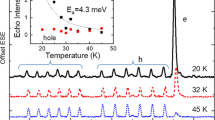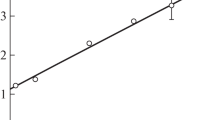A considerable number of investigations have by now been made on optical pumping of spin-oriented electrons in semiconductors. The optical-pumping method makes it possible to produce easily a high polarization of the electron spins in the conduction band, and to detect it optically [1–3]. The use of this method for the investigation of semiconductors turned out to be very fruitful; the spin orientation of the minority [1–3] and majority [4] carriers was determined, the lifetimes of the non-equilibrium electrons were measured [2, 3, 5], the mechanisms of spin relaxation of “cold” [2, 5] and “hot” [2, 6] electrons were investigated, spin orientation of excitons was effected [7], and electron paramagnetic resonance with non-equilibrium electrons was registered [8].
Similar content being viewed by others
Avoid common mistakes on your manuscript.
It was shown in [1, 9] that a number of effects due to the interaction of light-induced polarized electrons with magnetic moments of the nuclei of the main lattice of the crystal can appear in experiments on optical pumping. It was observed in [1] that such an interaction leads to dynamic polarization of the nuclei (the Overhauser effect), i.e., the light-produced spin polarization is transferred from the electron system to the nuclear system. This phenomenon was revealed by the change of the nuclear magnetization (by the change of the magnitude of the NMR signal). In an earlier paper [9] we have shown that in the presence of strong spin relaxation of the nuclei the interaction with nuclear magnetic moments is a significant mechanism for the spin relaxation of electrons, but its effectiveness depends strongly on the nuclear magnetization (more accurately, on the difference between the degree of polarization of the electrons and the nuclei). Thus, the electronic and nuclear magnetizations produced by optical pumping turned out to be interrelated, so that changes in one of the spin systems (say the nuclear system) can be revealed by the change of the spin polarization of the other system (say the electronic one). Thus, in [9], the destruction of the nuclear magnetization by a weak transverse magnetic field (the Henle effect for polarized nuclei) was revealed by the change of the degree of stationary polarization of the electrons.
A change in the nuclear magnetization can be attained also under magnetic-resonance conditions. In the present study we have observed by an optical method a change in the stationary spin orientation of photoelectrons following saturation of the nuclear sublevels in a crystal by an alternating high-frequency field.
The experiments were performed on GaxAl1 – xAs crystals, in which all the atoms of the main lattice have nuclear magnetic moments. We have observed earlier [9] that in these crystals, at 4.2 K the stationary spin orientation of the photoelectrons is determined to a considerable degree by their interaction with the nuclei and depends strongly on the nuclear magnetization. The spin-oriented electrons were produced in the conduction band by excitation with circularly-polarized light. The degree of stationary orientation of the photoelectrons, as before [3–6], was measured optically by means of the degree of circular polarization of the photoluminescence. The crystal was placed in a permanent magnetic field oriented parallel to the propagation direction of the exciting light (parallel to the orientation of the spins of the electrons produced by the light). An alternating high-frequency field, which induced transitions between the nuclear sublevels split by the constant field H0, was applied in a perpendicular direction. The resonance was revealed by the change of the degree of circular polarization of the luminescence when the frequency of the high-frequency field was scanned.
Figure 1 shows the dependence of the degree of polarization of the luminescence on the frequency of the applied RP field for a constant field H0 = 2.6 kHz. We see that a strong increase of the degree of polarization of the luminescence (and consequently also of the degree of orientation of the electrons) is observed in the region of the RF field frequencies corresponding to magnetic resonance of the nuclei of the atoms of the principal lattice of the crystal. The appearing resonance lines have a doublet structure. With changing intensity of the constant magnetic field H0, the centers of the doublets shift linearly, but the magnitude of the doublet splitting remains approximately constant.
Degree of circular polarization of the luminescence of a Ga0.8Al0.2As crystal (excited by circularly- polarized light) on the frequency of the applied trans verse RF field. The longitudinal permanent magnetic field was H0 = 2.6 kHz. The arrows mark the positions of the nuclear-magnetic-resonance frequencies for the atoms of the principal lattice of the crystal in the given field Ho.
Thus, we succeeded for the first time in registering by optical means the change of the population of nuclear sublevels, produced in a crystal by the action of a radio frequency field. The observed phenomenon is analogous to electron nuclear double resonance (ENDOR). Unlike in ENDOR, however, the change of the electron polarization is detected optically. This circumstance offers a number of significant advantages. First, a high sensitivity: in our experiments the effect was clearly registered (with a signal/noise ratio 100 : 1) in the case when the stationary number of the light-produced electrons was only 109. In addition, the luminescence can be obtained from samples of very small dimensions. Thus, in our case we used for the excitation an He-Ne laser, and when its radiation was focused on the crystal, only a small fraction of the sample, with area ~0.1 mm2 and thickness ~1 μ, i.e., with a volume 10–7 cm3, takes part in the luminescence. It is clear that at such small dimensions of the investigated region one can dispense with the customarily very stringent requirements with respect to homogeneity of the constant magnetic field.
REFERENCES
G. Lampel, Phys. Rev. Lett. 20, 491 (1968).
R. R. Parsons, Phys. Rev. Lett. 23, 1152 (1969);
Can. J. Phys. 49, 1850 (1971).
A. I. Ekimov and V. I. Safarov, JETP Lett. 12, 198 (1970).
A. I. Ekimov and V. I. Safarov, JETP Lett. 13, 177 (1971).
D. Z. Garbuzov, A. I. Ekimov, and V. I. Safarov, JETP Lett. 13, 24 (1971).
A. I. Ekimov and V. I. Safarov, JETP Lett. 13, 495 (1971).
E. P. Gross, A. I. Ekimov, B. S. Razbirin, and V. I. Safarov, JETP Lett. 14, 70 (1971).
C. Hermann and G. Lampel, Phys. Rev. Lett. 27, 373 (1971).
A. I. Ekimov and V. I. Safarov, JETP Lett. 15, 179 (1972).
ACKNOWLEDGMENTS
We are grateful to V. Berkovets for help with organizing the experiment and V.I. Perel’ and M.I. D’yakonov for discussions.
Funding
This work was supported by ongoing institutional funding. No additional grants to carry out or direct this particular research were obtained.
Author information
Authors and Affiliations
Corresponding author
Ethics declarations
The authors of this work declare that they have no conflicts of interest.
Additional information
Publisher’s Note.
Pleiades Publishing remains neutral with regard to jurisdictional claims in published maps and institutional affiliations.
Rights and permissions
Open Access. This article is licensed under a Creative Commons Attribution 4.0 International License, which permits use, sharing, adaptation, distribution and reproduction in any medium or format, as long as you give appropriate credit to the original author(s) and the source, provide a link to the Creative Commons license, and indicate if changes were made. The images or other third party material in this article are included in the article’s Creative Commons license, unless indicated otherwise in a credit line to the material. If material is not included in the article’s Creative Commons license and your intended use is not permitted by statutory regulation or exceeds the permitted use, you will need to obtain permission directly from the copyright holder. To view a copy of this license, visit http://creativecommons.org/licenses/by/4.0/.
About this article
Cite this article
Ekimov, A.I., Safarov, V.I. Optical Electron-Nuclear Resonance in Semiconductors. Jetp Lett. 118 (Suppl 1), S21–S22 (2023). https://doi.org/10.1134/S002136402313009X
Received:
Revised:
Accepted:
Published:
Issue Date:
DOI: https://doi.org/10.1134/S002136402313009X





